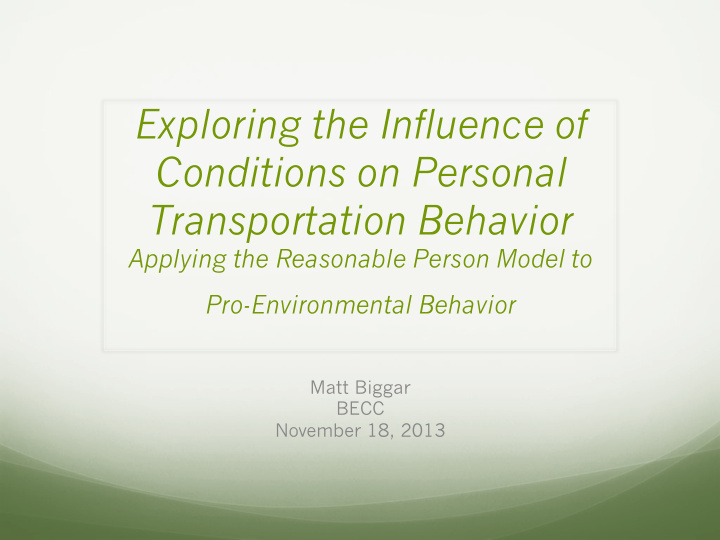



Exploring the Influence of Conditions on Personal Transportation Behavior Applying the Reasonable Person Model to Pro-Environmental Behavior Matt Biggar BECC November 18, 2013
SF to Palo Alto: An Informational Journey of 32 Miles, 2 Kids and 1 Commuter Safety Information Schedule Information Real Time Information Options Information and Knowledge of System
Pro-Environmental Behavior (PEB) and Personal Transportation Personal Transportation PEB- “difficult to achieve” ( Corbett, 2005; Wals & Schwarzin, 2012, Steg & Vlek, 2009 ) yet high impact ( Leon & Brower, 1999; Shulman, S., et al., 2012 Tanner, 1999 ) pro-environmental behavior Motivation for Research: How do we shift behavior in personal transportation?
The Intention-Behavior Gap Environmental Behavior Theories/Models Theory of Planned Behavior (Azjen & Fishbein, 1985; Azjen, 1991) Model of Responsible Environmental Behavior (Hines, Hungerford & Tomera, 1987) Values-Beliefs-Norms model (Stern, 2000) Intention-Behavior Gap: theories strongly predict intention and predisposition but not behavior (Armitage & Conner, 2007; Bamberg & Moser, 2007; Stern, 2005) Attitude-Behavior Gap (Heimlich & Ardoin, 2008; Tanner, 1999; Blake, 1999)
Conditions for Pro- Environmental Behavior Intercede intention and behavior Conditions ( Kaplan & Kaplan, 2009; Steg & Vlek, 2002; Kollmuss &Agyeman, 2002; Schultz, 2002; learning- Barron, 2004 ) can support or inhibit behavior and are defined as factors that constitute the physical, social and conceptual context for an individual. Information related needs “We are a species with immense dependence on information…we can’t live without it, but are readily impaired by its abundance.” (Kaplan 2011)
Reasonable Person Model (RPM) To bring out the best in people, conditions must meet people’s need to Explore and understand (model building) Be competent, clear-headed (being effective) Participate and make a difference (meaningful action)
Research Study Teacher Institute setting- 32 teachers Personal Climate Action Plans 5 case studies (longitudinal)- personal transportation (purposive sample)
Research Methods Three interviews of each participant Short written surveys Document analysis Observation of institute Data analysis- a priori and open coding Individual vignettes
Individual Summaries Bus/walk to work 2 days/week - mostly successful Family support; difficult with daily schedule Bike to work every day - very successful Support from many; multiple personal benefits; overcomes barriers No car twice a week - somewhat successful Some family and friends opposed or not supportive Subway/walk to work at least 3 days/week - very successful Found system convenient and dependable; bonds with other riders Bus to work twice a week- not successful No family or other support; limited experience
Findings: Influence of Conditions on Behavior Conditions matter (RPM) Social conditions Experiencing personal control and benefits of behavior (RPM with Theory of Planned Behavior) Information access and use (RPM) as one factor Self-Interest and Motivation Competency (RPM) as direct and motivating influence Personal benefits Social benefits
SF to Palo Alto: The Whole Story Supportive conditions Information Social influences Learning through experience Future research Role of information, social influences and learning through experience on overcoming barriers and changing habits in personal transportation
Recommend
More recommend